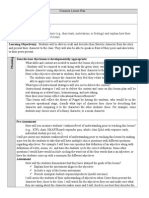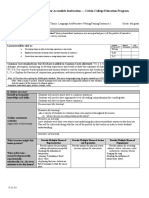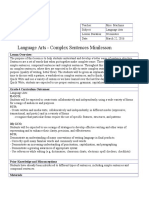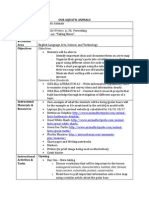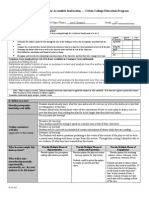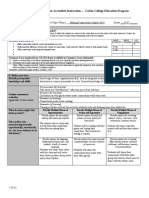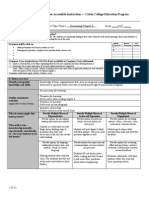Lessonplan5 1
Lessonplan5 1
Uploaded by
api-337264205Copyright:
Available Formats
Lessonplan5 1
Lessonplan5 1
Uploaded by
api-337264205Original Title
Copyright
Available Formats
Share this document
Did you find this document useful?
Is this content inappropriate?
Copyright:
Available Formats
Lessonplan5 1
Lessonplan5 1
Uploaded by
api-337264205Copyright:
Available Formats
Lesson Planning Form for Accessible Instruction Calvin College Education Program
Teacher: Janneke Cole
Date: 10/26/16
Subject/ Topic/ Theme: Language Arts/Narrative Writing/Transitions
Grade: 6th Grade
I. Objectives
How does this lesson connect to the unit plan? This lesson covers transitions, has students edit their narrative piece, and finally
type their own story.
cognitiveR U Ap An E C*
Learners will be able to:
Identify transitional words, phrases, and clauses as transitions to manage the sequence of events in a story.
R, U, An
Use commas to separate introductory elements from the rest of the sentence
Ap, C
Use transitional phrases effectively in their own writing
Ap, C
physical
development
socioemotional
Common Core standards (or GLCEs if not available in Common Core) addressed: W.5.3.c, L.5.2b.
*Note: ACS teachers have split up the 5th/6th grade standards. This unit is being taught using 5th grade standards per ACS language arts teachers request.
(Note: Write as many as needed. Indicate taxonomy levels and connections to applicable national or state standards. If an objective applies to particular learners
write the name(s) of the learner(s) to whom it applies.)
*remember, understand, apply, analyze, evaluate, create
II. Before you start
Identify prerequisite
knowledge and skills.
-Students will have had 4 other lessons regarding good narrative writing and should understand what
those lessons had to teach: conjunctions, interjections, sensory images, and character descriptions.
-Students should have a basic understanding of the comma
-Students should have written their own narrative story
Pre-assessment (for learning):
Students will have to try to identify why the Terrible Trip doesnt flow.
Formative (for learning):
Outline assessment
activities
(applicable to this lesson)
What barriers might this
lesson present?
What will it take
neurodevelopmentally,
experientially,
emotionally, etc., for your
students to do this lesson?
Formative (as learning):
Students will work in groups to edit The Terrible Trip. They will then tell the class what the
added/changed to make the piece transition smoothly between events.
Summative (of learning):
Students will have to turn in a notecard of a character description and/or sensory image they found in
their independent reading book.
Provide Multiple Means of
Representation
Provide options for perceptionmaking information perceptible
-Display the story on the board
-have the students read along on
their paper
-read the piece aloud to them.
Provide options for language,
mathematical expressions, and
symbols- clarify & connect
language
9-15-14
Provide Multiple Means of Action
and Expression
Provide options for physical actionincrease options for interaction
Provide Multiple Means of
Engagement
Provide options for recruiting
interest- choice, relevance, value,
authenticity, minimize threats
-Students identify a lack of
transitions in the example
-Students add transitions to
anothers writing
-Students add them to their own
writing.
Provide options for expression and
communication- increase medium
of expression
Provide options for sustaining
effort and persistence- optimize
challenge, collaboration, masteryoriented feedback
-Asking students to identify what is
missing (transitions)
-Asking students to add their own
transitions without much help from
the teacher
Provide options for comprehensionactivate, apply & highlight
Materials-what materials
(books, handouts, etc) do
you need for this lesson
and are they ready to
use?
Provide options for executive
functions- coordinate short & long
term goals, monitor progress, and
modify strategies
Provide options for self-regulationexpectations, personal skills and
strategies, self-assessment &
reflection
-Students adding their own
transitions to their own writingthey will have to learn it and
understand it in order to do so, and
will know that they dont
understand if they have trouble
adding them.
-Writing packet
-Interactive whiteboard
-Blue writing utensils
-Notecards for warm up.
Students will be in cluster groups of 4-5.
How will your classroom
be set up for this lesson?
III. The Plan
Time
Components
Describe teacher activities
AND
student activities
for each component of the lesson. Include important higher order thinking questions and/or
prompts.
Write this on the board before class:
Good morning, 6th graders!
10
min
10
min
Motivation
(opening/
introduction/
engagement)
Development
(the largest
component or
main body of
the lesson)
You may spend your warm up time reading your
independent reading book IN YOUR SEATS.
Look specifically for a character description and/or
a sensory image. When you find one, write it down
on the notecard provided. I will collect these after
warm up time.
-Instruct students to put their books away and to
turn their attention to you.
Students should return to their desks and put the
books away.
-Tell students that the writing lesson will focus on
how to use a variety of transitional words, phrases,
and clauses in their writing in order to create a clear
path for the reader.
-Display a copy of Linking/Transition Words and
Phrases and direct students to take their copy out.
-Tell students to also take out their Transitions
list.
-Review the list. Reinforce the point that transitions
words are like road signs for the reader, helping
them to stay on the right path from the beginning to
the end of the writing.
9-15-14
Students will enter the room and see the note on the
board. They will follow the directions and do the
warm up in their seats.
Students should take out the Transition words and
phrases sheet. (in their writing packet).
Students should also take out their Transitions
List sheet.
-Turn to the Terrible Trip story. Tell students to
pay attention to the flow of the story.
Students should listen to you read the story.
-Read the story to students.
-Ask students what they noticed about the
transitions between events. Guide them to say that
the story lacks flow because it is lacking good
transitions.
-Students should offer up their ideas as to what the
story is missing.
-Tell them youre going to edit the piece.
-Remind students that writers use commas and
transitions to create a clear path for the reader.
-Underline the first sentence. Ask them what
transitions they could add to the piece to make it
flow a bit more (using their transitions list).
(an example may be..My brother Colton, a few
of my buddies, and I had just gotten out of freezing
cold Higgins Lake. After playing a little catch with
my vortex football, we decided to organize a two
hand touch football scrimmage. First, we divided
the players up so that we would have fair teams.)
-Students will probably raise their hands with ideas
as to what to add.
-Instruct students to work in their group to fix the
rest of the first paragraph. Instruct them to use their
transitions list for ideas and to write the words in
blue marker.
-Walk around the classroom and take note of how
groups are doing.
Students will work with their cluster group to edit
the remainder of the first paragraph.
-Assist any groups that need assisting.
-When all groups have finished, ask the class what
they came up with.
-Listen to the group ideas as to how to fix the rest
of the first paragraph.
Students will offer up their suggestions as to how to
fix the paragraph.
-Correct any errors and guide students to have
completed a paragraph that flows.
-Instruct students to go through the second
paragraph and do the same thing.
-Continue walking around and listening to each
group.
(If students need it, they can go through the whole
story. However, I believe they will understand this
quite easily and going through the first two
paragraphs will be enough. They will continue to
learn transitions through the practice of putting
9-15-14
Students will work in groups to correct the second
paragraph.
transitions into their own stories.)
Closure
(conclusion,
culmination,
wrap-up)
-Instruct students to spend the remainder of their
time adding transitional words and phrases to their
own stories with their blue marker. If they find that
they have already used transitional words, they
should underline them in blue marker.
Students will spend the remainder of the class
period typing their piece.
(one student typed his from the beginning- he
will just need to go back and edit his based on the
edits he has made by hand since writing the initial
story.)
-Have them check their stories with you when they
are finished. If they are all set, they may begin
typing them.
Students should check their story with you when
they are finished.
-Tell students that the should have their stories
typed by_________ (what ever day is three days
later).
If they get the okay, students can type their story on
their computer.
Your reflection about the lesson, including evidence(s) of student learning and engagement, as well as ideas for improvement
for next time. (Write this after teaching the lesson, if you had a chance to teach it. If you did not teach this lesson, focus on the
process of preparing the lesson.)
I wasnt able to teach this lesson- I taught a different lesson (that Bethany organized) per Bethanys request. I
think this lesson would have gone well, as it doesnt contain too much information. I didnt have too much
trouble preparing the lesson- I was instructed to teach about transitions by Bethany, so choosing a topic
wasnt an issue. However, I did find it to be a bit of an abstract idea to teach. There are so many different ways
to transition in writing- it isnt like conjunctions and interjections in that there isnt an obvious right or wrong
answer. Sixth graders sometimes struggle with this, as they prefer to have a definite answer. I believe that
encouraging them to stick to the transition words on the list that they were given was helpful because it gave
them some guidelines as to what to include in their transitions. I believe they would have struggled quite a bit
more had I left it open ended for them.
9-15-14
You might also like
- Rump Lesson PlanDocument8 pagesRump Lesson Planapi-331892318No ratings yet
- Second Language Acquisition by Rod EllisDocument21 pagesSecond Language Acquisition by Rod EllisZakariaOudra93% (14)
- sp18 Common Lesson Plan Template Small Group LessonDocument4 pagessp18 Common Lesson Plan Template Small Group Lessonapi-505035881No ratings yet
- Speaking and Listening Lesson PlanDocument4 pagesSpeaking and Listening Lesson Planapi-296333288No ratings yet
- Lessonplan2 3Document5 pagesLessonplan2 3api-337264205No ratings yet
- Lessonplan1 4Document6 pagesLessonplan1 4api-337264205No ratings yet
- Lesson5 2Document3 pagesLesson5 2api-270339587No ratings yet
- sp18 Common Lesson Plan Template - Whole Group LessonDocument8 pagessp18 Common Lesson Plan Template - Whole Group Lessonapi-505035881No ratings yet
- Tla Co-TeachingDocument6 pagesTla Co-Teachingapi-242472770No ratings yet
- Lessonplan4 2Document4 pagesLessonplan4 2api-337264205No ratings yet
- Lesson Plan 2 FinalDocument4 pagesLesson Plan 2 Finalapi-270413105No ratings yet
- Poetry Lesson 2 ExaggerationDocument7 pagesPoetry Lesson 2 Exaggerationapi-213611948No ratings yet
- Lesson Plan 3 For Unit PlanDocument3 pagesLesson Plan 3 For Unit Planapi-302452610No ratings yet
- Poe Lesson PlanDocument4 pagesPoe Lesson Planapi-264609339No ratings yet
- Lesson 3Document3 pagesLesson 3api-302454223No ratings yet
- Complex Sentences Lessonplan1Document7 pagesComplex Sentences Lessonplan1api-310531318No ratings yet
- Lesson Plan - Singluar and Plural - FinalDocument4 pagesLesson Plan - Singluar and Plural - Finalapi-302003110No ratings yet
- Unit Plan Lesson 3Document3 pagesUnit Plan Lesson 3api-338231293100% (1)
- Lesson Four - ValleysDocument3 pagesLesson Four - Valleysapi-283707491No ratings yet
- Millicent Atkins School of Education: Common Lesson Plan TemplateDocument4 pagesMillicent Atkins School of Education: Common Lesson Plan Templateapi-405934378No ratings yet
- Lesson Planning Form For Accessible Instruction - Calvin College Education ProgramDocument4 pagesLesson Planning Form For Accessible Instruction - Calvin College Education Programapi-302454223No ratings yet
- Writing Lesson 3Document2 pagesWriting Lesson 3api-273812022No ratings yet
- Inferencinglessontws-Lesson OneDocument4 pagesInferencinglessontws-Lesson Oneapi-238367895No ratings yet
- Our Aquatic Animals Title of Class Book Adapted From Grade Level & Content Area ObjectivesDocument6 pagesOur Aquatic Animals Title of Class Book Adapted From Grade Level & Content Area ObjectivesAlexandra KeresztesNo ratings yet
- STEPP Lesson Plan Form: Content Standard(s) Addressed by This LessonDocument6 pagesSTEPP Lesson Plan Form: Content Standard(s) Addressed by This Lessonapi-264548225No ratings yet
- Lesson 2Document3 pagesLesson 2api-245823147100% (1)
- Educ-302-Lesson Four FinalDocument4 pagesEduc-302-Lesson Four Finalapi-252316801No ratings yet
- 5 Unit Lesson Plan 5Document5 pages5 Unit Lesson Plan 5api-337360126No ratings yet
- Edtpa-Aligned Lesson For All ClassesDocument12 pagesEdtpa-Aligned Lesson For All Classesapi-267736442No ratings yet
- Lesson Number FiveDocument3 pagesLesson Number Fiveapi-284181679No ratings yet
- 3 Timeline Lesson ModifiedDocument4 pages3 Timeline Lesson Modifiedapi-337281159No ratings yet
- Siop Lesson Plan With ReflectionDocument6 pagesSiop Lesson Plan With Reflectionapi-315708883100% (2)
- 1-Scoe Lesson Planning Template Fa23 2 1Document5 pages1-Scoe Lesson Planning Template Fa23 2 1api-583052012No ratings yet
- Lesson 2 Unit PlanDocument5 pagesLesson 2 Unit Planapi-300384449No ratings yet
- Lesson Plan 2 PT 2Document5 pagesLesson Plan 2 PT 2api-337360126No ratings yet
- Eddn 637 - Siop LessonDocument8 pagesEddn 637 - Siop Lessonapi-710356152No ratings yet
- Lesson 4Document4 pagesLesson 4api-245823147No ratings yet
- Lesson 1Document3 pagesLesson 1api-245823147No ratings yet
- Lesson Plan - Hardworking PDFDocument5 pagesLesson Plan - Hardworking PDFapi-337243635No ratings yet
- 7 Steps of Writing A LPDocument4 pages7 Steps of Writing A LPSera MystNo ratings yet
- Argh WeplanfinalDocument9 pagesArgh Weplanfinalapi-266085341No ratings yet
- Day 1 LessonDocument3 pagesDay 1 Lessonapi-284253105No ratings yet
- Lesson 7 Outsiders CH 5Document14 pagesLesson 7 Outsiders CH 5api-349579702No ratings yet
- Velazquez-Writers WorkshopDocument4 pagesVelazquez-Writers Workshopapi-318497518No ratings yet
- Lesson Three - HillsDocument3 pagesLesson Three - Hillsapi-283707491No ratings yet
- Unit Plan Lesson 5Document3 pagesUnit Plan Lesson 5api-337406556100% (1)
- Lesson Plan 3 Educ 302Document8 pagesLesson Plan 3 Educ 302api-315445685No ratings yet
- Lesson Plan 2Document3 pagesLesson Plan 2api-283392025No ratings yet
- Lesson 7Document2 pagesLesson 7api-273233127No ratings yet
- Lesson Planning - PreparedDocument4 pagesLesson Planning - Preparedapi-337243635No ratings yet
- Millicent Atkins School of Education: Common Lesson Plan TemplateDocument6 pagesMillicent Atkins School of Education: Common Lesson Plan Templateapi-382117266No ratings yet
- Cbup LP3Document4 pagesCbup LP3Jane PatrickNo ratings yet
- Lesson 3Document3 pagesLesson 3api-245823147No ratings yet
- Lesson 5Document3 pagesLesson 5api-302454223No ratings yet
- Lesson Plan 6Document3 pagesLesson Plan 6api-338034395No ratings yet
- Lesson Planning Form For Accessible Instruction - Calvin College Education ProgramDocument4 pagesLesson Planning Form For Accessible Instruction - Calvin College Education Programapi-284183356No ratings yet
- Millicent Atkins School of Education: Common Lesson Plan TemplateDocument37 pagesMillicent Atkins School of Education: Common Lesson Plan Templateapi-444858079100% (1)
- Poetry Lesson 3 - SimilesDocument6 pagesPoetry Lesson 3 - Similesapi-213611948No ratings yet
- (If Applicable, If Not Explain Why) : (Demonstration of Learning)Document3 pages(If Applicable, If Not Explain Why) : (Demonstration of Learning)api-282904450No ratings yet
- Eddn 637 - Siop LessonDocument8 pagesEddn 637 - Siop Lessonapi-710356152No ratings yet
- Nonfiction Writing Strategies Using Content-Area Mentor TextsFrom EverandNonfiction Writing Strategies Using Content-Area Mentor TextsNo ratings yet
- Untitleddocument 2Document2 pagesUntitleddocument 2api-337264205No ratings yet
- DiaryentriesrubricDocument1 pageDiaryentriesrubricapi-337264205No ratings yet
- FormalwritingrubricDocument2 pagesFormalwritingrubricapi-337264205No ratings yet
- Lessonplan4 2Document4 pagesLessonplan4 2api-337264205No ratings yet
- Rubricforunitplan 3Document1 pageRubricforunitplan 3api-337264205No ratings yet
- KCOM 112 Syfer Personal NotesDocument20 pagesKCOM 112 Syfer Personal Notesthaboadonis467No ratings yet
- Practice Noun&AnswerDocument3 pagesPractice Noun&AnswerBryanAnanta SinuhajiNo ratings yet
- Coaching ConversationsDocument34 pagesCoaching Conversationsapi-319316325100% (2)
- Superlativos y Comparativos en InglesDocument9 pagesSuperlativos y Comparativos en InglesEliana Vega BravoNo ratings yet
- WF - RT 1 & 2Document25 pagesWF - RT 1 & 2moonorsunNo ratings yet
- Gerunds and InfinitivesDocument13 pagesGerunds and Infinitivesnimra4940No ratings yet
- Hebrew Grammar NotesDocument25 pagesHebrew Grammar Noteshydnar100% (2)
- Ssale lp1 2 Superman MeDocument4 pagesSsale lp1 2 Superman Meapi-295875717No ratings yet
- Form 2 English Teaching Progress For Remedial ClassDocument5 pagesForm 2 English Teaching Progress For Remedial ClassmaydoniNo ratings yet
- Grade 2 Literacy Week 9 Lesson 3Document4 pagesGrade 2 Literacy Week 9 Lesson 3MARK DEFREITASNo ratings yet
- University Graduates' Workplace Language Needs As Perceived by Employers"Document5 pagesUniversity Graduates' Workplace Language Needs As Perceived by Employers"maizansofiaNo ratings yet
- Complex Imitation and The Language-Ready Brain: Michael A. ArbibDocument40 pagesComplex Imitation and The Language-Ready Brain: Michael A. Arbibappled.apNo ratings yet
- Introduction To French VerbsDocument4 pagesIntroduction To French VerbsR JayammaNo ratings yet
- Muhammad Rizal: English Into Indonesian Certified Legal Translator by The Association of Indonesian Translators (HPI)Document3 pagesMuhammad Rizal: English Into Indonesian Certified Legal Translator by The Association of Indonesian Translators (HPI)Muhammad RizalNo ratings yet
- Nittaya Campbell - How New Zealand Consumers Respond To Plain EnglishDocument25 pagesNittaya Campbell - How New Zealand Consumers Respond To Plain EnglishMario RossiNo ratings yet
- ODocument6 pagesOHei Nah MontanaNo ratings yet
- Using The Tarot and Fellowship of Fools For WritingDocument16 pagesUsing The Tarot and Fellowship of Fools For WritingMoon5627No ratings yet
- Advanced WritingDocument3 pagesAdvanced WritingElona LazajNo ratings yet
- Team Development and RolesDocument3 pagesTeam Development and RolesAllan CunninghamNo ratings yet
- Swedish Phase1 BKLTDocument36 pagesSwedish Phase1 BKLTAna Lopes100% (1)
- Answer Keys Class 8Document2 pagesAnswer Keys Class 8Bazlul KarimNo ratings yet
- Módulo de Revisión Final N°2Document4 pagesMódulo de Revisión Final N°2Paula LazarteNo ratings yet
- Bec Vantage 04Document28 pagesBec Vantage 04Anjali V Murthy100% (2)
- Proceedings 2013 PDFDocument104 pagesProceedings 2013 PDFrubenmena1No ratings yet
- FaircloughDocument12 pagesFaircloughBerliiani As Liiyha100% (1)
- 07-Unit 4 PDFDocument9 pages07-Unit 4 PDFajlinariNo ratings yet
- The TKT CLIL ModuleDocument7 pagesThe TKT CLIL ModuleJorge Hernandez Bernal100% (1)
- ADVERB Sharma Ji Classes PDFDocument25 pagesADVERB Sharma Ji Classes PDFsharmajiNo ratings yet
- UNIT 2 - Lesson 1Document4 pagesUNIT 2 - Lesson 1Millie AlonsoNo ratings yet



